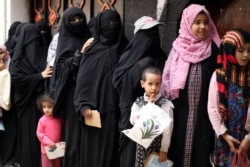The United Nations said Thursday that more than a thousand prisoners have been released from detention from both sides in Yemen’s conflict, in the largest prisoner swap since the start of the conflict in 2015.
“Since this morning, the skies of Yemen have seen an airlift of hope,” U.N. Special Envoy for Yemen Martin Griffiths told the U.N. Security Council from Amman, Jordan. “I commend the parties and their respective leadership for their commitment to constructively negotiate and successfully reach this agreement.”
Diplomats said 1,081 detainees, mainly Yemeni, are being released and transported home over two days starting Thursday, in accordance with an agreement negotiated in Montreux, Switzerland last month. Among them, some Saudi citizens were also repatriated. Griffiths said no women were among those released, but that the list of detainees was drawn up by the parties.
Several thousand detainees remain in custody of the warring parties, but Thursday’s release is the biggest so far in the conflict.
“We hope that today’s release operation is a good first step towards building the confidence needed between parties to the conflict in order to bring even more good news for Yemenis,” Fabrizio Carboni, ICRC Regional Director for Near and Middle East, said from Yemen, where he was overseeing the transport operation.
The International Committee of the Red Cross (ICRC) is acting as a neutral intermediary in transporting the former detainees. The aid organization is also carrying out medical checks to be sure individuals are healthy enough to travel, as well as following coronavirus prevention protocols in transporting them.
Famine looms
Despite the first good news on the political front in many months, the situation remains grim for millions of Yemenis, who could soon be facing famine.
“Experts are increasingly worried that the window to prevent famine in Yemen is closing,” U.N. Humanitarian Chief Mark Lowcock told the council.
The country, which was already the region’s poorest before the fighting, has teetered on the brink of famine before, and in a world with no shortage of suffering, it stands out as the largest humanitarian emergency for its size and scope. This year, the U.N. has appealed for $3.2 billion for needs, but funding gaps are larger than previous years and some programs have already been forced to suspend services, even in the midst of rising coronavirus cases. Add to the equation the country’s plummeting currency, and affordable food has been placed beyond the reach of many families.
“And despite Yemen’s hunger crisis, farms are attacked with alarming regularity,” Lowcock noted. “The Norwegian Refugee Council estimates that air strikes and shelling have hit farms more than 900 times since 2018 – that’s about once every day.” The Saudi-led coalition controls the skies over Yemen.
He said that aid agencies are currently reaching about 9 million people monthly – down from 13 million a month at the start of 2020.
“What is to be the fate of the 4 million we no longer have the money to help?” he asked.
“Given current conditions in Yemen, I am not convinced that humanitarian agencies – even were they to have more funding – can prevent famine now if there is no accompanying support for the economy,” the U.N. humanitarian chief warned.
Lowcock and envoy Griffiths have repeatedly called for a nationwide cease-fire to halt the suffering.
Griffiths has been carrying out shuttle diplomacy for the past seven months working to get the Saudi-backed Yemeni government and the Iranian-supported Houthi rebels to agree to a joint declaration that would cover a nationwide cease-fire, economic and humanitarian measures, and the resumption of the political process.
Griffiths told reporters after the council meeting that the parties are getting “closer and closer” to eliminating issues of contention, but “we need to get it over the line” and “see that document signed.”








